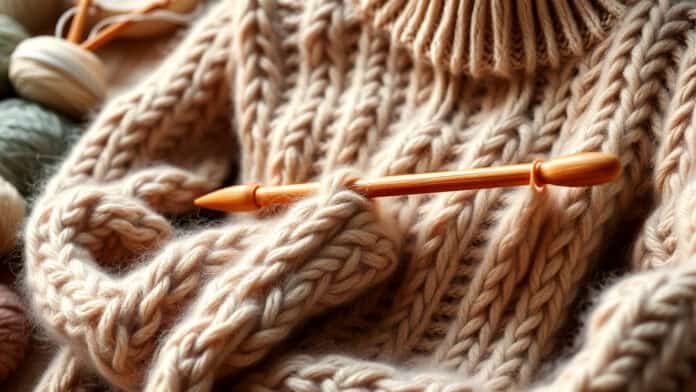Easy Mohair Knitting Patterns
Mohair yarn is a knitter’s dream. It’s soft, shiny, and comes from Angora goats. This yarn is perfect for cozy, lightweight garments. But, knitting with mohair can be tricky. It tends to stick and tangle, making mistakes hard to fix. Luckily, its fluffiness can hide small errors.
Choosing the right tools is key. Larger needles, like US 11 or 13, are ideal. They help create an airy texture. Wooden or bamboo needles can provide extra grip.
Ready to start? A simple mohair scarf is a great beginner project. Try a test swatch first. Use basic stitches like garter or stockinette. Let the yarn’s beauty shine through.
Key Takeaways
- Mohair yarn is soft, shiny, and made from Angora goats, perfect for warm garments.
- Use larger needles, like US 11 or 13, for an airy texture with mohair.
- Start with a test swatch to understand mohair’s unique knitting characteristics.
- Try oversized patterns for sweaters to highlight mohair’s softness and warmth.
- Find free mohair patterns on sites like Ravelry to practice and explore new styles.
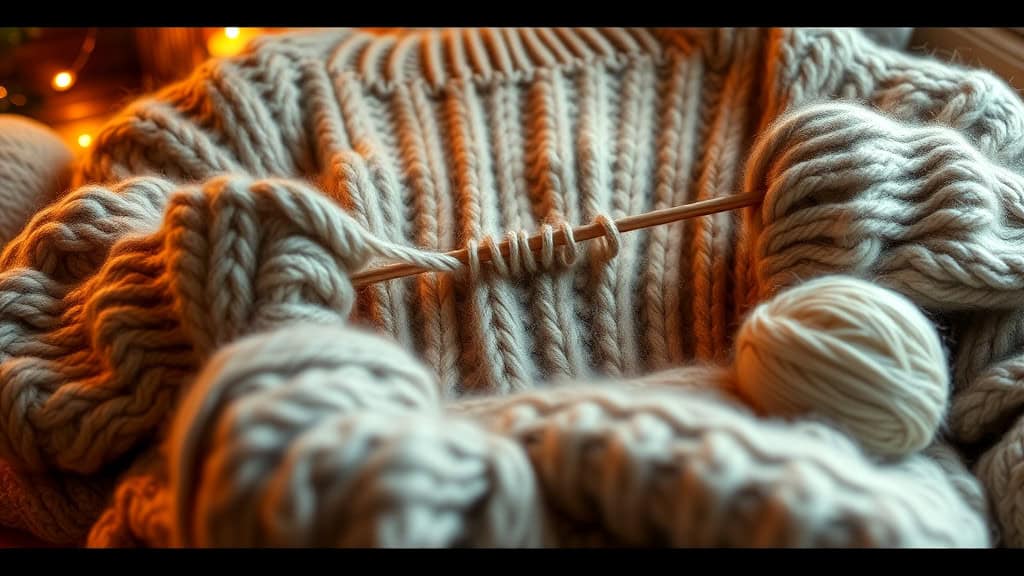
Understanding Mohair Yarn Basics
Grasping the basics of mohair yarn can be a game-changer for crafting. Mohair’s luxurious texture and warmth make it popular, yet the yarn’s sticky nature can test your patience. Picture this: you’re halfway through an intricate pattern, and a small error arises. No sweat! Mohair’s fluffiness can mask tiny mistakes, making them less noticeable.
Selecting the right needles is like choosing the perfect dance partner. Larger needles create an open-knit fabric, ideal for showcasing mohair’s natural beauty. Some folks find that wooden or bamboo needles offer more control, preventing the yarn from slipping away like a mischievous cat.
Wouldn’t it be great if you could combine mohair with other yarns? This not just amps up the texture but adds another layer of warmth. Think of it as a cozy hug during winter. For those diving into easy mohair knitting patterns, starting with simple projects like scarves can build confidence. Simple stitches allow mohair to show off its elegance.
Have you ever wanted to knit a sweater that feels like wrapping yourself in a cloud? Consider patterns that bring out mohair’s softness. Oversized designs are a hit, giving you that effortless chic look while keeping you snug.
For inspiration, check out free patterns that let you play with different styles without commitment. A treasure trove of designs awaits enthusiastic knitters, eager to unleash their creativity and perfect their skills.
Table: Easy Mohair Knitting Patterns Options
| Project Type | Recommended Needle Size | Suggested Yarn Combination | Ideal For |
|---|---|---|---|
| Scarf | US 11 (8.0 mm) | Mohair + Silk | Beginners |
| Sweater | US 13 (9.0 mm) | Mohair + Wool | Intermediate |
| Hat | US 10 (6.0 mm) | Mohair + Alpaca | Quick Projects |
| Shawl | US 9 (5.5 mm) | Mohair + Cashmere | Advanced Techniques |
| Blanket | US 15 (10.0 mm) | Mohair + Merino | Cozy Home Accessories |
List: Tips for Working with Mohair Yarn
- Use larger needles to create an airy texture.
- Mix mohair with other fibers for added warmth.
- Keep projects simple to highlight mohair’s natural sheen.
- Choose patterns that suit mohair’s unique characteristics.
- Experiment with different needle materials for better control.
- Don’t stress over small mistakes—mohair can conceal them well.
- Explore free patterns to try new techniques without risk.
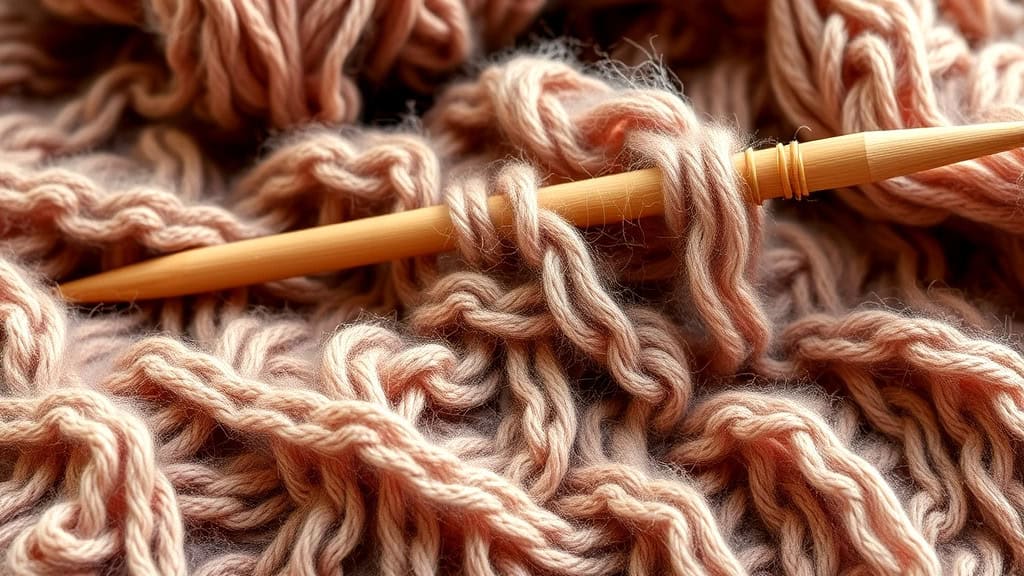
Choosing the Right Needles and Tools
When you’re eyeing needles and tools for Easy Mohair Knitting Patterns, think big! Larger needles, like US 11 or 13, can make mohair’s fuzzy nature pop. The airy vibe you get is perfect for that cozy, open-knit look. Some folks love using wooden or bamboo needles, claiming they add a bit of grip. This can help keep that slippery mohair in check. It’s like the difference between walking on ice and walking on a carpet; one’s just less likely to cause a tumble.
Needle material plays a crucial role too. Metal needles are slick and fast, but sometimes, a little too slick. It’s like trying to hold onto a bar of soap in the shower. Wooden or bamboo needles slow things just enough, offering control. It’s the Goldilocks of knitting tools—not too fast, not too slow, but just right. This choice can be the difference between a smooth sail and a shipwreck in your knitting journey.
Fancy tools aren’t a must, but a few extras can be helpful. Think stitch markers. These little guys are lifesavers for keeping track of rows in your Easy Mohair Knitting Patterns. They’re like breadcrumbs on a path, ensuring you don’t lose your way. Muddling through tangled yarn? A yarn needle is your magic wand. It can help weave in ends and fix those tiny knots before they become big headaches.
Lastly, patience is your best tool. Mohair isn’t the easiest co-pilot, but it rewards your patience with stunning results. Imagine a fluffy cloud you can wear. Mistakes happen, but mohair’s forgiving nature usually hides these tiny critters. Allow yourself some grace, and remember that knitting is more about the journey than the destination.
| Needle Size | Material | Recommended For | Result |
|---|---|---|---|
| US 11 (8mm) | Bamboo | Beginners | Airy, open texture |
| US 13 (9mm) | Wood | Intermediate | Lightweight finish |
| US 11 (8mm) | Metal | Experienced | Fast knitting |
| US 13 (9mm) | Bamboo | All skill levels | Enhanced grip |
| US 11 (8mm) | Plastic | Casual knitting | Smooth glide |
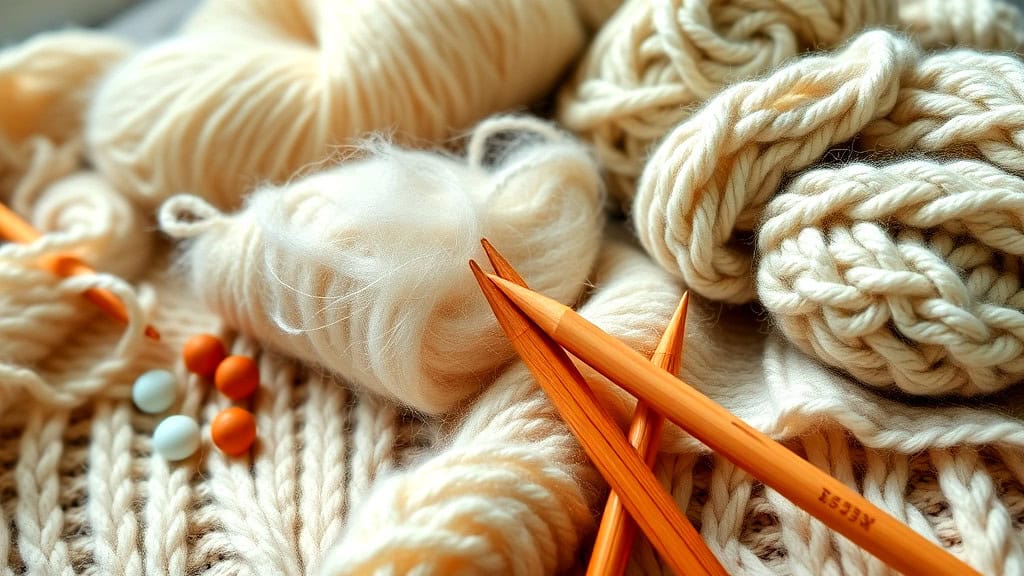
Step-by-Step Guide to a Simple Mohair Scarf
To embark on knitting a simple mohair scarf, begin with choosing your preferred mohair yarn. Consider both the color and texture that speak to you, as these elements will define your scarf’s personality. Test knitting with a small swatch to become acquainted with the yarn’s unique feel and behavior.
Once comfortable, cast on stitches using larger needles, like US 11 or 13, to create a lightweight fabric. This setup will allow the mohair’s natural fluff to come through beautifully. If you’re feeling fancy, add a touch of another yarn for a textured effect.
Start with basic stitches such as garter stitch for ease, or stockinette for a smoother finish. The key is to keep it simple and let the mohair’s charm shine. Keep your tension relaxed; mohair likes to breathe. If you make a mistake, no worries! Mohair is forgiving—errors might blend in like they were meant to be.
As you knit, pay attention to how the yarn feels in your hands. Wooden or bamboo needles can be friendly with mohair, offering a non-slip experience. But hey, if you like a bit of a challenge, metal needles can add excitement and speed to your project. It’s all about what tickles your fancy.
Every few rows, step back and admire your handiwork. This helps you see the progress and keeps motivation high. It’s like watching a caterpillar turn into a butterfly!
Once you reach your desired length, cast off loosely. This ensures the scarf has a gentle drape, perfect for those chilly days when you need a hug from your trusty scarf.
Lastly, blocking your scarf might not be necessary, but if you want to pamper it, a gentle steam can refine the edges. Remember, this is your creation—enjoy every loop and stitch.
And there you have it—a cozy mohair scarf, crafted with love and care. Wear it proudly or gift it to someone special. It’s not just a scarf; it’s a piece of art and warmth you’ve made with your own hands.
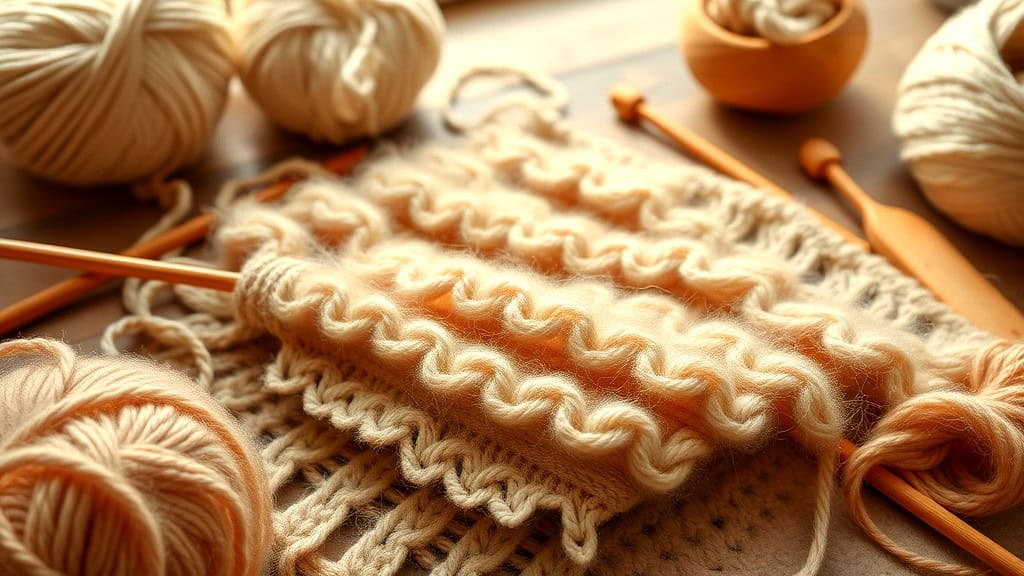
Tips for Creating a Cozy Mohair Sweater
Thinking about creating a cozy mohair sweater? Begin with easy mohair knitting patterns that highlight the yarn’s softness. Opt for oversized styles. They are forgiving with minor errors and ensure comfort. Patterns like “Love Note” are excellent for adventurous beginners. Double-check pattern notes to avoid hiccups.
When selecting yarn, blend mohair with other fibers for added warmth. It can soften any itchiness. Choose colors that complement your wardrobe. Mohair’s natural sheen looks stunning in rich tones, adding elegance.
Consider the needles. Larger ones, like US 13, create an airy knit. Wooden needles are great because they grip the yarn better, reducing slippage. They’re your best friends when working with mohair.
Knitting with mohair can be tricky. It sticks and tangles. If you make a mistake, it might be tough to fix. But don’t sweat it! Its fluffiness can hide small errors. Stay patient, and keep snacks nearby for stress munching!
Gauge is important. Knit a test swatch before diving into the pattern. This helps ensure your sweater fits like a dream. You don’t want surprises when you slip it on.
Layering is key. Mohair is warm but lightweight. Consider a loose-knit design that allows for layers underneath. This way, your sweater becomes versatile, perfect for chilly mornings or breezy afternoons.
Blocking transforms your finished piece. A little steam can set stitches and enhance drape. It’s like magic for your sweater, making it look polished.
Have fun with embellishments. Think about adding simple patterns or cables. They add texture and interest without overwhelming the yarn. Remember, knitting should be an enjoyable journey, not just a destination.
And when you’re done, wear your sweater proudly. It’s more than just clothing. It’s a testament to your patience and creativity. Share it with friends over hot cocoa or keep it as your cozy secret.
| Tip | Description | Benefit |
|---|---|---|
| Choose Oversized Patterns | Highlight mohair’s softness | Forgiving with errors |
| Use Larger Needles | Open-knit fabric | Enhances drape |
| Blend with Other Yarns | Adds warmth | Softens itchiness |
| Consider Embellishments | Adds texture | Enhances interest |
| Block Finished Piece | Sets stitches | Enhances fit |
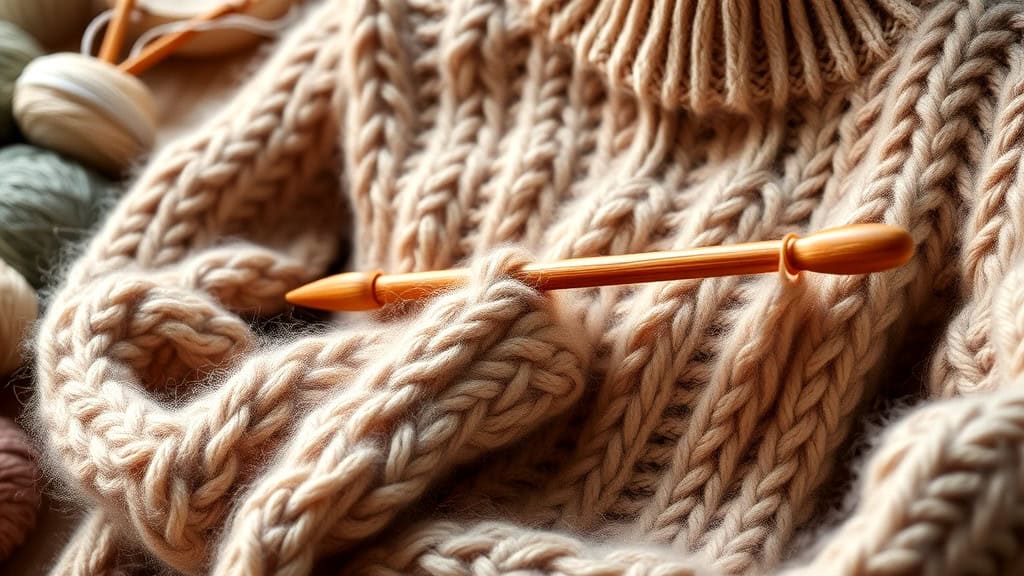
Top 5 Free Mohair Patterns to Try
Delve into these five standout mohair knitting projects that are both free and accessible. Perfect for those looking to expand their repertoire, these easy mohair knitting patterns combine simplicity with style.
- The Featherlight Wrap: Picture a cozy evening wrapped in a light, airy shawl. This pattern is perfect for beginners, using simple stitches to highlight mohair’s fluffiness. You’ll love the gentle warmth it provides, without any heaviness.
- Breezy Mohair Beanie: Keep your head warm and stylish with this beanie. The pattern is straightforward, ideal for those new to mohair. Choose a vibrant color for a pop of fun, or keep it neutral for a classic look.
- Cloud-Like Cowl: Imagine wearing a piece that feels just like a hug. This cowl pattern wraps you in softness and is incredibly easy to make. Its circular design is forgiving, even if your stitching isn’t perfect.
- Dreamy Cardigan: Want to add a touch of elegance to your wardrobe? This free cardigan pattern allows you to create a flowy, sophisticated piece with minimal effort. Just right for layering over any outfit, it’s a wardrobe staple.
- Sleek Mohair Mitts: Perfect for chilly days, these mitts keep your hands warm while allowing your fingers to move freely. An excellent project for those who like quick, satisfying knits.
- Luxe Lace Scarf: This pattern offers a chance to play with texture and design. The lacework, though simple, creates a stunning effect that looks more complex than it is. Who doesn’t love a compliment on their handiwork?
- Soft Mohair Socks: Treat your feet to a cozy delight. These socks are not just warm but stylish too. Perfect for lounging around, they make excellent gifts.
Each pattern offers a unique way to enjoy the beauty of mohair. Embark on these projects and watch your knitting skills flourish. Whatever your choice, these patterns promise warmth and style. Let mohair’s softness guide your knitting journey.
Conclusion
Knitting with mohair is like cuddling with a cloud—soft and oh-so-cozy. It’s perfect for crafting scarves and sweaters that feel luxurious. The yarn can be a tad tricky, but the rewards are worth it. Remember, practice makes perfect!
Choosing the right tools is key. Larger needles and the right type can make a world of difference. Don’t let the yarn’s quirks discourage you. Embrace the fluff and enjoy the process! Explore free patterns to find what tickles your fancy. With a bit of patience, your mohair projects will become cherished wardrobe staples. Dive in and let your creativity flow!
FAQ
- What makes mohair yarn special for knitting?
Mohair is derived from the Angora goat. It is incredibly soft and has a lovely sheen. It creates garments that are both lightweight and warm. Its fluffiness can even mask minor knitting mistakes. However, it can be tricky to knit as it sticks and tangles easily.
- What kind of needles should I use with mohair yarn?
Larger needles like US 11 (8.0 mm) or US 13 (9.0 mm) are great. They help create an airy, open-knit fabric. Wooden or bamboo needles are also a good choice. They provide more grip and prevent the yarn from slipping.
- How can I start knitting a simple mohair scarf?
Begin with a test swatch to get familiar with the yarn. Cast on enough stitches using large needles to achieve a fluffy texture. Use basic stitches like garter or stockinette. The yarn’s natural beauty will shine through these simple stitches.
- What should I consider when knitting a mohair sweater?
Oversized patterns enhance mohair’s softness and warmth. Look for patterns accessible to beginners, like the “Love Note” by Tin Can Knits. Always check for any pattern errata to sidestep potential errors while knitting.
- Where can I find free mohair patterns to try?
Ravelry is a fantastic resource for free mohair patterns. You can experiment with different styles and techniques without any cost. Check out patterns like the “Syrinx” or “Misty Harbor” sweaters. They use laceweight mohair-silk yarns for added elegance.

